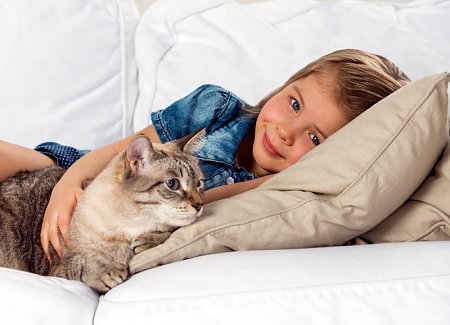Thinking of getting a cat? How about your kids?
What is the best way to introduce a cat to children? One at a time. If you have multiple kids, introduce one kid at a time to the cat. It’s easier for parents to keep an eye on a fast moving child and an even faster cat, if there’s only one of each to watch.
Practice Makes Perfect (Sense)
A stuffed animal is a good way to practice with young children. Point out Kitty’s eyes, ears, nose and toes. Remind that a tail helps him keep his balance when he runs—it’s not a handle. Show how to hold a cat—under the front legs with support under the backside, not dangling or dragging by one leg.
Little hands might have good intentions but they don’t always have the best coordination. What starts out as a gentle touch can swing wild and come down too hard. Practice on the stuffed Kitty for control. Never leave a small child and a cat unsupervised—one will be afraid and hiding, the other bleeding and crying.
Cats come with a built in time limit for petting. Some want to be lap cats for the afternoon while others have a lower tolerance. Teach small children how to count and say, “Let’s pet Kitty four times. One, two, three, four. Take a break.”
A wadded up piece of paper, a cat and a child are hours of entertainment. The fishing pole toy is another way to wear out an active child and energetic cat. Trailing each other around the house can lead to peaceful naptimes. Just make sure the pole isn’t used to poke or hit.
Children too young to help pour dry food or water into bowls can remind parents when they get up from naps, “It’s time to feed the kitty.” To keep the curious out of the litter box, teach the child to come tell you when Kitty’s used the box. They can hold the bag while you scoop or open the trash can for you.
Older Children
Older children have different ideas about the entertaining value of cats. Boys may want to play too rough while girls might dress the cat in doll clothes and push him in a buggy. Set limits from Day One. No giving the cat a bath, no teaching him to swim, and no “will he really land on his feet?” tricks.
Teach children to respect a cat as a living being, not as disposable and not as a toy.
Involve kids in the food/water/litter routine and let them come along during a vet visit to see how the exam and shots are done. Ask the veterinarian to show them how the scanner works for Kitty’s microchip.
Stress the importance of keeping Kitty indoors. Older children can tell their friends to make sure doors are closed and to watch out for Kitty. During parties, holidays and other hectic times, Kitty might be more comfortable in another room where it’s peaceful and quiet.
Cats startle easily. Remind kids it’s not cool to sneak up on the cat and scare him. If a cat scratches or bites, there’s no excuse to hit Kitty in retaliation.
Allergies?
Rather than bring a cat home only to discover your child is allergic, ask if your veterinarian has a friendly office cat, visit a shelter or drop by the pet supply store on adoption day. See how your child reacts to the cats and kittens before you adopt.
With some pre-planning and preparation, cats and kids are a great combination.
Last but not least, if you’re considering a cat as a gift for your kids – read this first.
Comments? Leave them using the form below. Questions? Please use the cat forums for those!


